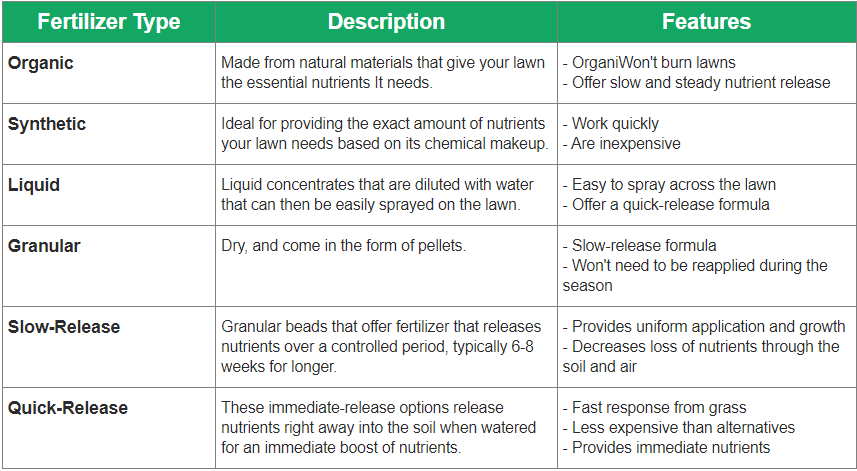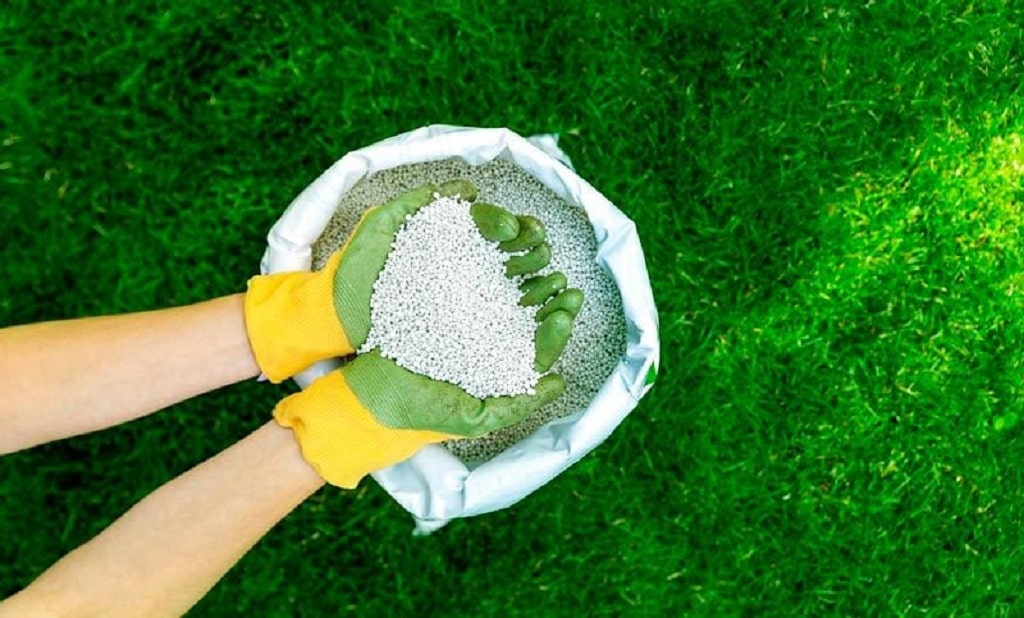KNOW YOUR LABELS
Lawn fertilizers typically consist of three primary nutrients, listed in the following order on the package: nitrogen, phosphorus, and potassium (N-P-K). For other types of plants, fertilizers may contain different ingredients in varying quantities. To achieve optimal results, it is important to use fertilizers specifically formulated for grass.

The N-P-K ratio indicates the percentage by weight of each nutrient present. For instance, a common type of all-purpose fertilizer is labeled as 10-10-10, indicating that it contains 10 percent nitrogen, 10 percent phosphorus, and 10 percent potassium. Additional ingredients in the fertilizer provide other nutrients and act as fillers.
Nitrogen (N) promotes vigorous growth and vibrant green color in your lawn. Phosphorus (P) aids in the development of healthy root systems. Starter lawn fertilizers contain a higher phosphorus content to support this root growth, while fertilizers for established lawns have a relatively lower amount. Lastly, potassium (K) enhances overall grass health and contributes to disease resistance, drought resilience, and cold tolerance.
To help remember these numbers, keep the phrase "up, down, and all-around" in mind when reading fertilizer labels. The first number represents rapid growth ("up"), the second number signifies root development ("down"), and the third number supports the overall health of your grass ("all-around").
TYPES OF FERTILIZERS
When it comes to lawn fertilizers, the choices can be overwhelming. The best fertilizers for your lawn depend on various factors. Whether you lean towards organic or synthetic, granular or liquid fertilizers (and so much more), we've got you covered. In this guide, we break it all down for you, ensuring you make the right choice for your lawn.
 (https://earthdevelopmentinc.com/blog/how-to-pick-the-right-fertilizer-for-your-lawn)
(https://earthdevelopmentinc.com/blog/how-to-pick-the-right-fertilizer-for-your-lawn)
WHEN TO FERTILIZE
Late spring and summer are the prime growing seasons for warm-season grasses, with temperatures averaging between 80 and 95°F. Keep a close watch on your lawn as growth may initiate below or above this temperature range. For optimal results, time your spring fertilization when the grass begins to turn green. Aim to provide warm-season grasses with 3 to 4 pounds of nitrogen-rich fertilizer per 1,000 square feet of lawn annually. You have the option to choose between slow- or quick-release fertilizer types, ensuring that the application is fully absorbed before high temperatures set in. After fertilizing, thoroughly water the grass, allowing the grains to penetrate the soil for complete absorption. Be cautious not to overwater and create runoff. Once the peak summer heat subsides, consider applying a second round of fertilizer.

- Avoid applying nitrogen-rich fertilizer when your lawn is dormant.
- Nitrogen, a crucial element in fertilizer, contains a growth stimulant that may lead to unwanted weed growth if applied during dormancy. If you've endured a long winter and your grass isn't actively growing yet, it's wise to postpone your scheduled fertilizer treatment.
- Read the product label.
- When considering the purchase of lawn fertilizer, it is important to carefully examine the product labels to determine the duration of effectiveness. Certain time-release fertilizers gradually release nutrients over a span of 2 to 8 months. It is crucial to allow enough time between applications to prevent overfertilization, which can harm your lawn.
- Don’t apply fertilizer right after a rainstorm.
- If your lawn has recently been drenched by a rainstorm, it's advisable to wait for a day or two before fertilizing. This allows the soil to dry out, preventing runoff and the wastage of fertilizer when you water it. Applying fertilizer to dry grass also increases the chances of it reaching the soil instead of clinging to the grass blades. By following these steps, you can ensure optimal effectiveness and efficiency in fertilizing your lawn.
- The best time to fertilize grass is when the ground warms up to 55 degrees Fahrenheit.
- As winter gives way to spring and the ground temperatures consistently reach 55°F for several days, dormant plants, including grass, begin to awaken and show signs of renewed growth. This marks the perfect time for fertilization. Applying fertilizer before this period would be futile.
- When autumn arrives, the ground temperatures during this season are typically suitable for fertilizer application. However, if a frost occurs and chills the ground, the opportunity has passed. In that scenario, you'll need to wait until the following spring.
- Avoid fertilizing your grass with certain products after seeding your lawn.
- If you have recently reseeded your lawn, it is acceptable to apply fertilizer. However, it is important to use a product specifically designed for the reseeding period. These fertilizers are often referred to as "starter" fertilizers, and they typically have a nitrogen to phosphorus ratio of 1:1 or close to that.
- Phosphorus is crucial for seed development, as it promotes strong root growth and helps the plant resist diseases. On the other hand, nitrogen is essential for leaf development. Therefore, it is recommended to use a nitrogen-rich fertilizer approximately 6 to 8 weeks after seeding.
- When seeding a brand-new lawn, it is best practice to fertilize the soil with starter fertilizer before spreading the seed. This is also an opportune time to assess the overall health of the soil, which can be done using a readily available soil test kit.
(Courtesy of: https://www.bobvila.com/articles/when-to-fertilize-lawn/)
